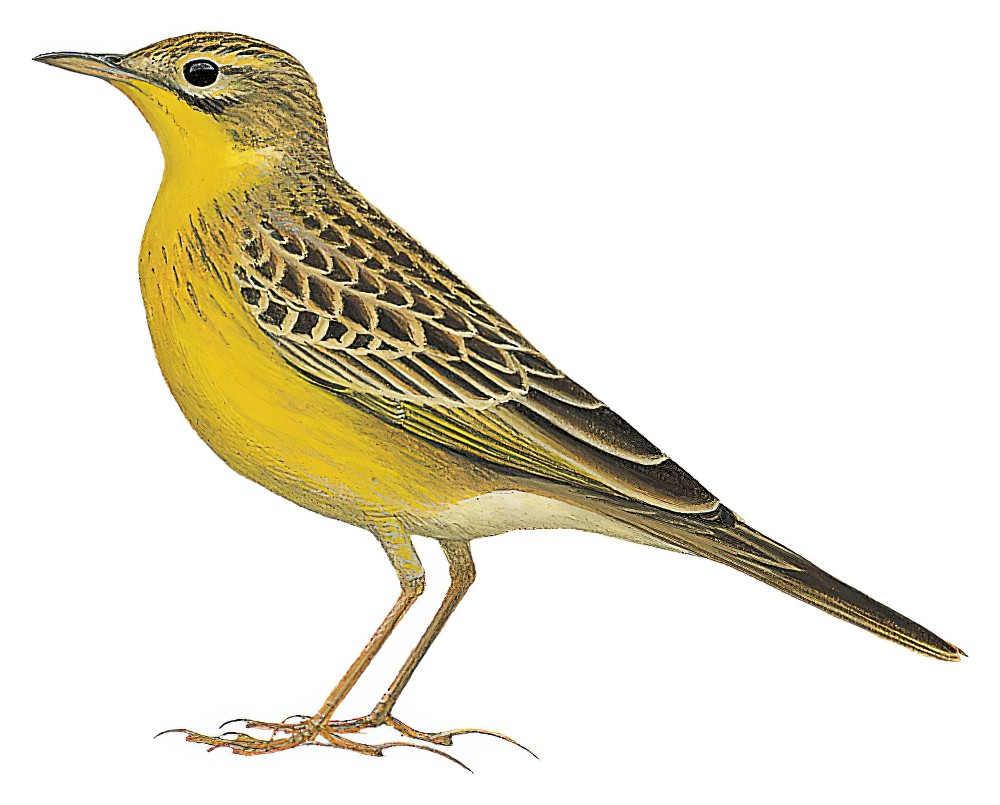Yellow-breasted Pipit / Hemimacronyx chloris

Yellow-breasted Pipit
SCI Name:
Protonym: Anthus chloris Verz.Samml.Vog.Kaffernl. p.13
Taxonomy: Passeriformes / Motacillidae / Hemimacronyx
Taxonomy Code: yebpip2
Type Locality: Kaffirland = Cape Province.
Author: Lichtenstein, MHC
Publish Year: 1842
IUCN Status: Vulnerable
DEFINITIONS
HEMIMACRONYX
(Motacillidae; Ϯ Yellow-breasted Pipit H. chloris) Gr. ἡμι- hēmi- small < ἡμισυς hēmisus half; genus Macronyx Swainson, 1827, longclaw; "Still another genus remains to be dealt with, namely, HEMIMACRONYX gen. nov., type Anthus chloris Sund., which is characterised by its yellow breast and slender toes and claws, which are long and, in common with the colour, remind one of the Yellow Wagtails. It has little in common with the other plainer coloured Pipits and would seem to be allied to Tmetothylacus, which differs in having the lower part of the tibia not feathered, and is a link between the Pipits and the Longclaws (Macronyx)." (A. Roberts 1922); "Hemimacronyx A. Roberts, 1922, Annals Transvaal Mus., VIII (4), p. 258. Type, by original designation, Anthus chloris Sund., i.e. Lichtenstein, 1842." (JAJ 2020).
CHLORIS
(Fringillidae; Ϯ European Greenfinch C. chloris) Specific name Loxia chloris Linnaeus, 1758; "Verdiers ...... Chloris" (Cuvier 1800); "Chloris Cuvier, 1800, Lecons Anat. Comp., 1, tab. 2. Type, by tautonymy, Loxia chloris Linnaeus." (Paynter in Peters, 1968, XIV, p. 234).
Synon. Chlorospiza, Hypacanthis, Ligurinus.
● (Parulidae; syn. Setophaga Ϯ Northern Parula S. americana) Gr. myth. Chloris the nymph, also known as Flora, wife to Zephyrus and goddess of flowers and springtime (Bob Dowsett in litt.); "Chloris: Sylv. americana Lath. u.s.w." (Boie 1826); "Chloris (not of Cuvier, 1800) Boie, Isis, 1826, p. 972—type, by virtual monotypy, Sylvia americana Latham = Parus americanus Linnaeus." (Hellmayr, 1935, Cat. Birds Americas, Pt. VIII, p. 347).
chloris
● Gr. χλωρις khlōris, χλωριδος khlōridos greenfinch < χλωρος khlōros green. In Gr. myth. Chlōris was one of the daughters of Pierus, who, having failed to best the Muses in a singing contest, was transformed into a finch (or a magpie, according to some!) (Acanthisitta, Chloris (see below), syn. Chlorodrepanis flava, Piprites).
● Mod. L. chloris green, greenish < Gr. χλωρις khlōris, χλωριδος khlōridos greenfinch < χλωρος khlōros green (cf. Gr. myth. Meliboea, a daughter of Niobe and Amphion, who was so traumatised by the slaughter of her siblings by a vengeful Apollo that she turned pale and changed her name to Chloris, the pale one) (Anthus, syn. Camaroptera brachyura (ex “Olivert” of Levaillant 1801-1804, pl. 125), subsp. Melanocharis longicauda, Nicator, syn. Picus canus, subsp. Sicalis olivascens, subsp. Thapsinillas affinis, Todiramphus (ex “Martin-pêcheur à tête verte du cap de Bonne Espérance” of d’Aubenton 1765-1781, pl. 783, fig. 2, and “Green-headed Kingsfisher” of Latham 1782), Zosterops, unident. (ex “Chloris Indicus” of Aldrovandus 1599-1603, and “Oriolus Indicus” of Brisson 1760)).
● "96. LOXIA. ... Chloris. 20. L. flavicanti-virens, remigibus primoribus antice luteis, rectricibus lateralibus quatuor basi luteis. Fringilla eadem. Fn. svec. 202. Chloris. Gesn. av. 259. Will. orn. 129. Raj. av. 85. n. 4. Alb. av. I. p. 56. t. 58. Frisch. av. l. 8. f. 3. 4. Aldr. orn. l. 18. c. 18. Habitat in Europa. Media quasi inter Loxias & Emberizas, sed rostrum crassius quam in Emberizis." (Linnaeus 1758) (Chloris).
UPPERCASE: current genus
Uppercase first letter: generic synonym
● and ● See: generic homonyms
lowercase: species and subspecies
●: early names, variants, mispellings
‡: extinct
†: type species
Gr.: ancient Greek
L.: Latin
<: derived from
syn: synonym of
/: separates historical and modern geographic names
ex: based on
TL: type locality
OD: original diagnosis (genus) or original description (species)












